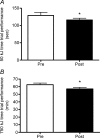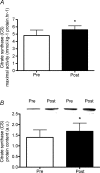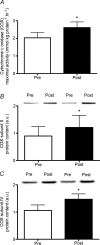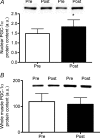A practical model of low-volume high-intensity interval training induces mitochondrial biogenesis in human skeletal muscle: potential mechanisms
- PMID: 20100740
- PMCID: PMC2849965
- DOI: 10.1113/jphysiol.2009.181743
A practical model of low-volume high-intensity interval training induces mitochondrial biogenesis in human skeletal muscle: potential mechanisms
Abstract
High-intensity interval training (HIT) induces skeletal muscle metabolic and performance adaptations that resemble traditional endurance training despite a low total exercise volume. Most HIT studies have employed 'all out', variable-load exercise interventions (e.g. repeated Wingate tests) that may not be safe, practical and/or well tolerated by certain individuals. Our purpose was to determine the performance, metabolic and molecular adaptations to a more practical model of low-volume HIT. Seven men (21 + or - 0.4 years, V(O2peak) = 46 + or - 2 ml kg(-1) min(-1)) performed six training sessions over 2 weeks. Each session consisted of 8-12 x 60 s intervals at approximately 100% of peak power output elicited during a ramp V(O2) peak test (355 + or - 10 W) separated by 75 s of recovery. Training increased exercise capacity, as assessed by significant improvements on both 50 kJ and 750 kJ cycling time trials (P < 0.05 for both). Skeletal muscle (vastus lateralis) biopsy samples obtained before and after training revealed increased maximal activity of citrate synthase (CS) and cytochrome c oxidase (COX) as well as total protein content of CS, COX subunits II and IV, and the mitochondrial transcription factor A (Tfam) (P < 0.05 for all). Nuclear abundance of peroxisome proliferator-activated receptor gamma co-activator 1alpha (PGC-1alpha) was approximately 25% higher after training (P < 0.05), but total PGC-1alpha protein content remained unchanged. Total SIRT1 content, a proposed activator of PGC-1alpha and mitochondrial biogenesis, was increased by approximately 56% following training (P < 0.05). Training also increased resting muscle glycogen and total GLUT4 protein content (both P < 0.05). This study demonstrates that a practical model of low volume HIT is a potent stimulus for increasing skeletal muscle mitochondrial capacity and improving exercise performance. The results also suggest that increases in SIRT1, nuclear PGC-1alpha, and Tfam may be involved in coordinating mitochondrial adaptations in response to HIT in human skeletal muscle.
Figures







Comment in
-
Exercise training for a time-poor generation: enhanced skeletal muscle mitochondrial biogenesis.J Physiol. 2010 Jun 1;588(Pt 11):1817-8. doi: 10.1113/jphysiol.2010.190199. J Physiol. 2010. PMID: 20516347 Free PMC article. No abstract available.
-
Just HIT it! A time-efficient exercise strategy to improve muscle insulin sensitivity.J Physiol. 2010 Sep 15;588(Pt 18):3341-2. doi: 10.1113/jphysiol.2010.196303. J Physiol. 2010. PMID: 20843832 Free PMC article. No abstract available.
References
-
- Booth FW, Roberts CK. Linking performance and chronic disease risk: indices of physical performance are surrogates for health. Br J Sports Med. 2008;42:950–952. - PubMed
-
- Bruce CR, Anderson MJ, Carey AL, Newman DG, Bonen A, Kriketos AD, Cooney GJ, Hawley JA. Muscle oxidative capacity is a better predictor of insulin sensitivity than lipid status. J Clin Endocrinol Metab. 2003;88:5444–5451. - PubMed
Publication types
MeSH terms
Substances
Grants and funding
LinkOut - more resources
Full Text Sources
Other Literature Sources
Medical
Miscellaneous

